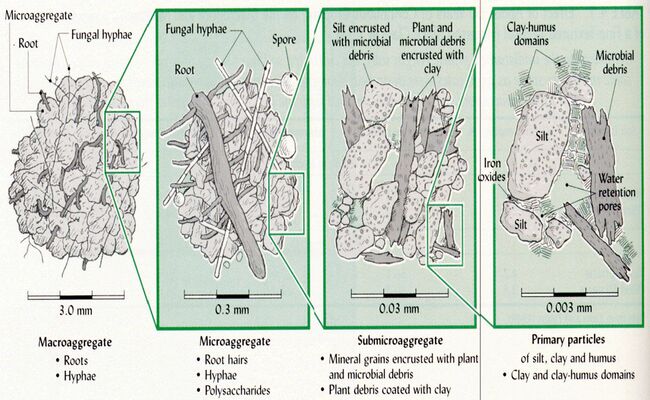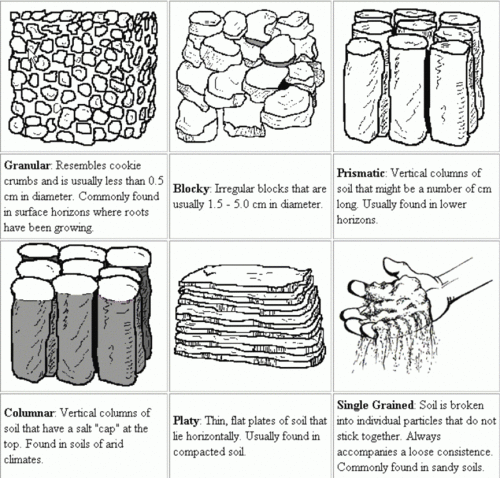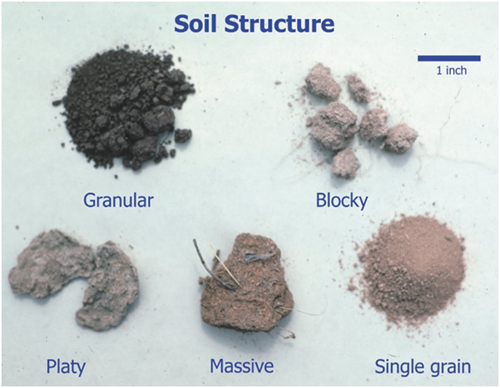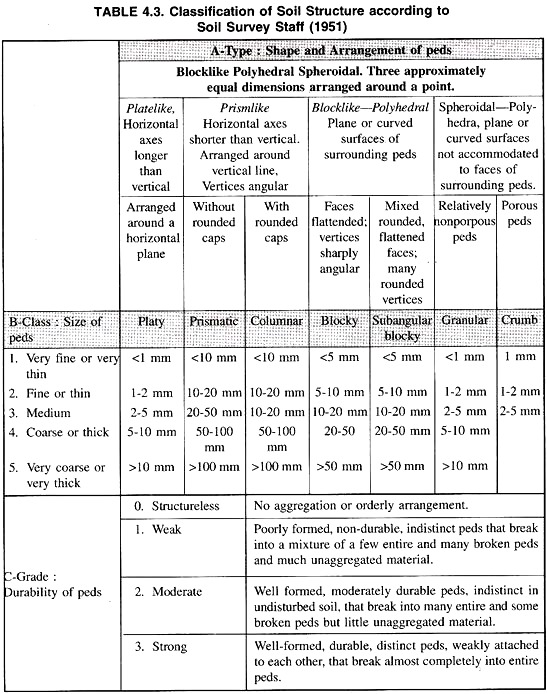Soil Structures: Difference between revisions
| (31 intermediate revisions by 2 users not shown) | |||
| Line 1: | Line 1: | ||
==[[Soil]] Structure== | ==[[Soil]] Structure== | ||
Soil structure refers to | Soil structure refers to the arrangement or groups of soil particles. These arrangements can be composed of particles ranging from nonstructural loose coarse grains to aggregates like chunks of sod. [5] Soil structures also encompass the pore space between soil particles. Pore spaces are air pockets found between particles in the soil and can vary greatly in size. Large pore spaces allow water to move quickly through the soil while small pore spaces between particles allow for high absorption rates and hold onto liquids tightly. Soil structure is achieved when soil particles experience cohesion forces that are greater than adhesion. Cohesion forces allow soil particles to clump, bind, and aggregate ([[aggregate formation]]). Stabilization is achieved through bonding agents such as plant, microbial polysaccharides, and gums. [5] Roots and Fungal Hyphae such as mycorrhizal fungi can act as bonding agents. Some soils have a lack of structure; this occurs when no particles stay in place with an introduction of a disturbance such as a shovel blade. [7] Soil structure influences ecosystem [[properties]] such as water retention, soil water movement, erosion, nutrient recycling, root penetration, and crop yield. [2] | ||
Soil structure can be observed as a soil mass when, under stress, it breaks along planes. These planes form the boundary of structural units called a “ped”, which have different spatial soil particle arrangements. [7] Clods are formed through artificial human-caused disturbances such as a mechanical disturbance (tilling a field). Such disturbances allow denser particles to be configured to the surface in the layer. [7] One soil may have various peds based on shape in the subsurface and surface horizons. [5] Peds are shaped by temperature, moisture, chemical, and biological conditions. Each of these conditions may vary depending on the level in the soil horizon. [5] The Pedon is the area of soil structure being categorized. It can be as small as 1 square meter or as large as 10 square meters. [5] | |||
==Soil Structure Formation== | ==Soil Structure Formation== | ||
Soil structure is shaped by the input of organic compounds into the soil | Soil structure is shaped by the input of organic compounds into the soil along with plants, fungi, microbes, soil compaction, freezing-thawing, wetting, and drying events. [5] Aggregates are the physical and biological compounds which soil particles cohere to. Aggregation can be increased through root activity. Roots release Polygalacturonic Acid which acts to stabilize aggregates through a higher bond strength and a slower wetting rate. [2] The more fibrous a root is, the more macro-aggregation will occur within the [[rhizosphere]]. [2] One of the most important biotic influences on aggregates is [[Arbuscular Mycorrhizal Fungi|Arbuscular mycorrhizal fungi]] (AMF) through the release of Glomalin, a glycoprotein which acts to stabilize aggregates. [2] | ||
| Line 16: | Line 15: | ||
==Classification== | ==Classification== | ||
Soil structures can be classified by their size, structure, shape, and grade | Soil structures can be classified by their size, structure, shape, and grade. | ||
===Soil Size, | ===Soil Size, Shape, and Structure=== | ||
[[File:Soil structure.gif |500px]] | [[File:Soil structure.gif |500px]] | ||
| Line 24: | Line 23: | ||
'''Figure 2:''' The various soil structure types categorized based on grain size and shape. [2] | '''Figure 2:''' The various soil structure types categorized based on grain size and shape. [2] | ||
====Size==== | |||
Soil grain size refers to the size of individual grains/particles of soil. [[Clay]] soils have grains smaller than .002mm in diameter, [[silt]] particles range from .002mm to .05mm in diameter, and [[sand]] particles range from .05mm to 2.0mm in diameter. All of these particles cohere to create clumps which range in size from less than .05cm to 5cm. These clump sizes help to make up and classify soil structures. | |||
====Shape==== | |||
Shape, in relation to to soil structure, refers to how soil “clumps” cohere to one another. They can range from small granular pieces with limited consistency to large columnar clumps or platy sheets of soil. These shapes are apparent when the soil is disturbed and begins to break apart. | |||
====Structure==== | |||
Soil structure is classified based on both soil grain shape and size. Structure can be defined as granular, blocky, prismatic, columnar, platy, or single grained. Soil structures are defined by clump sizes which may be less than 0.5 cm in diameter, 1.5-5 cm in diameter, or greater than 5 cm in diameter. Soil structure influences water flow through soils. Soil structures with larger pore spaces allow for water to flow through them quickly with limited absorption. When soil structure is composed of many small particles, such as clay soils, liquid absorption rate will increase. Large pore spaces are associated with soil structures that are blocky, prismatic, columnar, platy, or massive while small pore spaces are associated with soil structures that are granular or single grained. | |||
[[File:Soil_structures_picture.png ]] | [[File:Soil_structures_picture.png ]] | ||
Latest revision as of 13:40, 18 April 2023
Soil Structure
Soil structure refers to the arrangement or groups of soil particles. These arrangements can be composed of particles ranging from nonstructural loose coarse grains to aggregates like chunks of sod. [5] Soil structures also encompass the pore space between soil particles. Pore spaces are air pockets found between particles in the soil and can vary greatly in size. Large pore spaces allow water to move quickly through the soil while small pore spaces between particles allow for high absorption rates and hold onto liquids tightly. Soil structure is achieved when soil particles experience cohesion forces that are greater than adhesion. Cohesion forces allow soil particles to clump, bind, and aggregate (aggregate formation). Stabilization is achieved through bonding agents such as plant, microbial polysaccharides, and gums. [5] Roots and Fungal Hyphae such as mycorrhizal fungi can act as bonding agents. Some soils have a lack of structure; this occurs when no particles stay in place with an introduction of a disturbance such as a shovel blade. [7] Soil structure influences ecosystem properties such as water retention, soil water movement, erosion, nutrient recycling, root penetration, and crop yield. [2]
Soil structure can be observed as a soil mass when, under stress, it breaks along planes. These planes form the boundary of structural units called a “ped”, which have different spatial soil particle arrangements. [7] Clods are formed through artificial human-caused disturbances such as a mechanical disturbance (tilling a field). Such disturbances allow denser particles to be configured to the surface in the layer. [7] One soil may have various peds based on shape in the subsurface and surface horizons. [5] Peds are shaped by temperature, moisture, chemical, and biological conditions. Each of these conditions may vary depending on the level in the soil horizon. [5] The Pedon is the area of soil structure being categorized. It can be as small as 1 square meter or as large as 10 square meters. [5]
Soil Structure Formation
Soil structure is shaped by the input of organic compounds into the soil along with plants, fungi, microbes, soil compaction, freezing-thawing, wetting, and drying events. [5] Aggregates are the physical and biological compounds which soil particles cohere to. Aggregation can be increased through root activity. Roots release Polygalacturonic Acid which acts to stabilize aggregates through a higher bond strength and a slower wetting rate. [2] The more fibrous a root is, the more macro-aggregation will occur within the rhizosphere. [2] One of the most important biotic influences on aggregates is Arbuscular mycorrhizal fungi (AMF) through the release of Glomalin, a glycoprotein which acts to stabilize aggregates. [2]
Figure 1 Soil Microaggregates. Note the influence of root fibers, hyphae, and microbial debris. Image From Tisdall & Oades, 1982 [10]
Classification
Soil structures can be classified by their size, structure, shape, and grade.
Soil Size, Shape, and Structure
Figure 2: The various soil structure types categorized based on grain size and shape. [2]
Size
Soil grain size refers to the size of individual grains/particles of soil. Clay soils have grains smaller than .002mm in diameter, silt particles range from .002mm to .05mm in diameter, and sand particles range from .05mm to 2.0mm in diameter. All of these particles cohere to create clumps which range in size from less than .05cm to 5cm. These clump sizes help to make up and classify soil structures.
Shape
Shape, in relation to to soil structure, refers to how soil “clumps” cohere to one another. They can range from small granular pieces with limited consistency to large columnar clumps or platy sheets of soil. These shapes are apparent when the soil is disturbed and begins to break apart.
Structure
Soil structure is classified based on both soil grain shape and size. Structure can be defined as granular, blocky, prismatic, columnar, platy, or single grained. Soil structures are defined by clump sizes which may be less than 0.5 cm in diameter, 1.5-5 cm in diameter, or greater than 5 cm in diameter. Soil structure influences water flow through soils. Soil structures with larger pore spaces allow for water to flow through them quickly with limited absorption. When soil structure is composed of many small particles, such as clay soils, liquid absorption rate will increase. Large pore spaces are associated with soil structures that are blocky, prismatic, columnar, platy, or massive while small pore spaces are associated with soil structures that are granular or single grained.
Figure 3: Soil structure types looking at soil samples [9]
Soil Grade
Grade referrers to the distinctness of soils. Three classes are chosen based on ease of separation into specific units and the particles ability to stick together.
Strong: Soil units separating cleanly into whole units with disturbance.
Moderate: Soil units are noticed as well-formed pre-disturbance. Post-disturbance, soil will separate into a mixture of primarily whole units, broken units and some material not in a unit
Weak: Soil units, when disturbed, are mostly not in units while some stay in units. Most soil particles will show no planes of weakness. If the soil surface arrangement differs from the particles within, this is still a soil structure compared to a uniform consistency showing no planes of weakness which is most likely a structureless soil sample. [7]
Figure 4: A soil structure classification table incorporating Shape/arrangement, structure class, and grade. [8]
References
1: "BlackHillsGarden.com." SOIL STRUCTURE. » BlackHillsGarden.com - Gardening Experience in the Black Hills, 2018. Web. 08 Mar. 2018.
2: Bronick, C.J., and R. La. "Soil Structure and Management: A Review." Shibboleth Authentication Request. The Ohio State University, Jan. 2005. Web. 07 Mar. 2018.
3:Buckman, H. O., & Brady, N. C. (1960). The nature and properties of soils: A college text of edaphology. New York: Macmillan.
4: Cakmak, A. S. Soil-structure Interaction. Vol. 43;43.;. New York;Southampton;Amsterdam;Boston;: Elsevier, 1987. Web. 6 Mar. 2018.
5: Coleman, D. C., D., A. C. J., & Hendrix, P. F. (2004). Fundamentals of soil ecology. Retrieved from https://ebookcentral.proquest.com
6: Gao W, Hodgkinson L, Jin K, Watts CW, Ashton RW, Shen J, Ren T, Dodd IC, Binley A, Phillips AL, Hedden P, Hawkesford MJ, Whalley WR (2016a) Deep
roots and soil structure. Plant Cell Environ 39:1662–1668
7:"Natural Resources Conservation Service." SSM - Ch. 3. Examination and Description of Soil Profiles | NRCS Soils. N.p., n.d. Web. 08 Mar. 2018.
8:"Soil Structure: Classification, Genesis and Evaluation." Soil Management. N.p., 20 July 2016. Web. 08 Mar. 2018.
9:"Soil Structure | Nature of Soil | Soil Definition | Components of Soil." ENCYCLOPEDIA OF ENGINEERING. N.p., 25 Dec. 2017. Web. 8 Mar. 2018.
10:TISDALL, J. M., and J. M. OADES. "Organic Matter and Water‐stable Aggregates in Soils." Journal of Soil Science. Blackwell Publishing Ltd, 28 July 2006. Web. 08 Mar. 2018.



